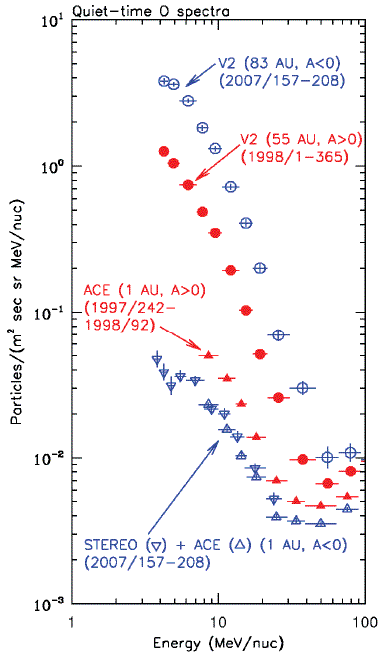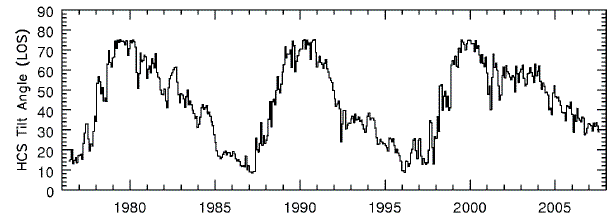
| ACE News Archives | ACE News #110 - September 28, 2007 |
Subscribe to ACE News |
As solar activity continues to decline towards solar minimum (presently predicted to occur in March 2008 ± 6 months; see http://www.sec.noaa.gov/SolarCycle/SC24/Statement_01.html), it is useful to examine the energy spectra of anomalous cosmic ray (ACR) oxygen at 1 AU and in the outer heliosphere to elucidate effects of the changing ACR source distribution and transport mechanisms. ACRs originate as interstellar neutral atoms that drift into the heliosphere, become singly-ionized by solar ultraviolet photons or by charge-exchange with the solar wind, and subsequently get carried to the outer heliosphere where they are accelerated. The Voyager spacecraft are presumably near the source of ACRs, although the precise location and acceleration mechanism of these particles is being debated because the energy spectra measured by Voyager 1 when it crossed the solar wind termination shock in December 2004 did not match theoretical expectations. A comparison of spectra measured at 1 AU and in the outer heliosphere may help constrain theories that seek to explain the ACR puzzle.
The ACR source distribution and transport mechanisms are both believed to
change over the course of the 22-year solar magnetic cycle. Currently, the
heliosphere is in the A<0 portion of the cycle in which the solar magnetic
field points into the Sun at its north polar region. During this time,
higher source intensity is expected in the helio-equatorial regions due to
the drift and acceleration of the particles along the termination shock.
At 1 AU the intensity is greatly reduced because the particles enter the
inner heliosphere primarily by drift along the warped heliospheric current
sheet. The larger the warp or tilt of the current sheet, the more
resistance the particles experience getting to the inner heliosphere. In
the figure at the upper right, the intensity at Voyager 2 (V2) for a
recent period during A<0 is ~50 times that at 1 AU at ~10 MeV/nuc. On the
other hand, when the solar magnetic field reverses, the particles drift
down from high latitude onto the equatorial plane and radial gradients are
small, consistent with zero at ~10 MeV/nuc for ACR O between ~40 and 60 AU
(Cummings et al., GRL, 1995). Consequently, the V2 A>0 intensity at 55 AU
in 1998 was only ~7.5 times larger than the A>0 intensity at 1 AU. In the
outer heliosphere, the V2 A<0 intensity is ~3 times greater than that
during A>0, consistent with the idea that the source intensity is greater
near the equatorial plane in A<0 than it is in A>0. The radial gradient in
the inner heliosphere has not been measured inside 5 AU during an A<0
solar minimum and this may be possible in the next few years using ACE,
STEREO, and Ulysses data.

The drift mechanism also produces latitudinal gradients, which are positive and relatively small during an A>0 solar minimum and negative and larger in an A<0 solar minimum, and they may alter this picture somewhat as the tilt of the current sheet continues to decline in the approach to solar minimum (see figure at lower right which uses data from the Wilcox Solar Observatory). Note that the tilt of the current sheet in 1985-86 is similar to what it was 11 years later in 1996-1997, ~10°, but the tilt in 2007 is much higher, ~30°. If the pattern from 11 and 22 years ago repeats itself, we expect a decline of the tilt in the very near future to ~10°. After this new current sheet topology propagates to the outer heliosphere over the course of about a year, the energy spectra may evolve significantly. We will continue to monitor the energy spectra as the heliosphere arrives at solar minimum.
This item was contributed by Alan Cummings, Edward Stone, Richard Mewaldt, and Rick Leske of Caltech. Address questions and comments to
Last modified 28 Sep 2007.